雨燕维修手册(英文)-上_部分2解析
T150K桥中英文维修手册1

一、概述General1、结构特点Structural features驱动桥作为底盘传动系统的主要部分,其主要功用是增大由发动机传来的扭矩,将扭矩分配给左右驱动轮,并使两边车轮具有差速功能。
同时,驱动桥还要承受路面和车架传来的各种作用力。
T150K驱动桥主要由驱动桥壳总成、主减速器总成、轮边减速器总成、制动器总成等几部分组成,为两级减速传动结构。
第一级减速即主减速装置,采用螺旋锥齿轮(格里森齿形)传动,具有输入扭矩大,传动效率高,工作平稳等特点。
第二级减速即轮边减速装置采用三个行星轮的行星减速传动结构(NGW型式),整体运动刚性好,输出速度平稳。
The main function of the driving axle, as the main part of the chassis system, is to enlarge the torque passed from the engine and distribute it to the left and right axles, making the wheels of two sides have differential function. Meanwhile, the driving axle needs to undertake various forces from the road-surface and the vehicle.Driving axle of T150Kmainly consist of the driving axle shell assembly, main reductor assembly, planetary reductor system, brake assembly, etc.. It is two grades of transmission. The first device is main reductor assembly drived by gleason bevel gear; the device is large in input torque, high in efficiency, stable in work. The second device is planetary reductor assembly drived by the planetary slowdown transmission structure with three planetary gears (NGW type), the device is high in rigidity, stable in output speed.2、工作原理Principle主机动力扭矩从输入法兰传入,由主减速器减速后,通过半轴将动力分别传给两侧轮边减速系统,再由轮边减速传动,将动力最终传给行星轮架,从而驱动轮胎滚动前进。
《Amarillo 轮子 Double Reduction Fan Drives 维修手册》说明书
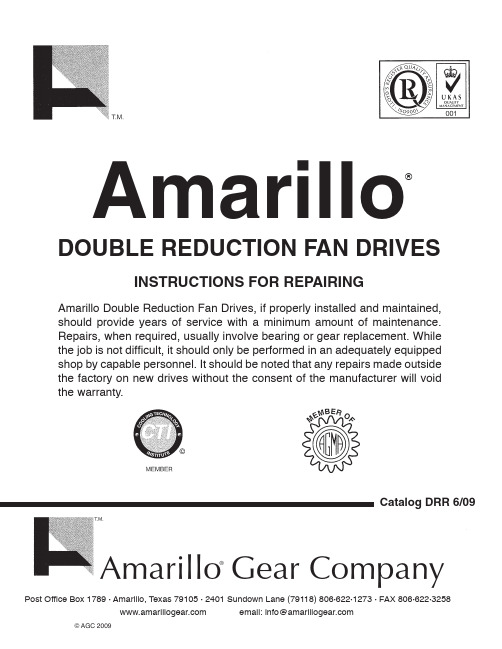
Amarillo Double Reduction Fan Drives, if properly installed and maintained,should provide years of service with a minimum amount of maintenance.Repairs, when required, usually involve bearing or gear replacement. Whilethe job is not difficult, it should only be performed in an adequately equippedshop by capable personnel. It should be noted that any repairs made outsidethe factory on new drives without the consent of the manufacturer will voidthe warranty.Catalog DRR 6/09Post Office Box 1789 • Amarillo, Texas 79105 • 2401 Sundown Lane (79118) 806•622•1273 • FAX 806•622•3258 email:*********************© AGC 2009DOUBLE REDUCTION FAN DRIVES INSTRUCTIONS FOR REPAIRING Amarillo®Amarillo Gear Company®- ATTENTION -Please note that gear drives with a serial number above 231989 have all joints sealed with Loctite Gasket Eliminator 515 instead of gaskets. Loctite 515 is a formed in place gasket material, which provides superior sealing over conventional gaskets. After disassembly for repair or inspection, we recommend resealing with Loctite 515. However, gaskets may still be used. If a gasket is utilized between the horizontal carrier and the gear case for a gear drive originally built with Loctite, the flange thickness of bearing bushing (20) or hardened washer (201), if applicable, will have to be changed to maintain the proper position of the horizontal gear. To correct the horizontal gear position, increase the horizontal spacer thickness by the thickness of the gasket. If Loctite is used to re-seal the gear drive then no changes are required to the horizontal spacer.TABLE OF CONTENTSPage1.0. General Disassembly Instructions (1)2.0. Disassembly of Input Shaft Assembly (5)2.2. Models 1008 and 1110 (5)2.3. Models 1311, 1712, 1712.5 and 1713 (8)3.0. Disassembly of Intermediate Shaft Assembly (8)4.0. Disassembly of Output Shaft Assembly (8)5.0. General Assembly Instructions (10)6.0. Assembly of Output Shaft Assembly (10)7.0. Assembly of Intermediate Shaft Assembly (10)8.0. Assembly of Input Shaft Assembly (11)8.2. Models 1008 and 1110 (11)8.3. Models 1311, 1712, 1712.5 and 1713 (12)9.0. Installation of Assemblies into Gear Case (12)10.0. Adjustment of the Input Shaft Bearings (13)11.0. Backlash Check (13)12.0. Spiral Bevel Tooth Contact Pattern Check (16)13.0. Adjustment of the Intermediate Shaft Bearings (16)14.0. Adjustment of the Output Shaft Bearings (16)15.0. Completion of Assembly (17)16.0. Disassembly of the Oil Pump (17)17.0. Assembly of the Oil Pump (17)18.0. Disassembly of the Input Stem Pinion Assembly (19)19.0. Assembly of the Input Stem Pinion Assembly (19)20.0. Spiral Bevel Tooth Contact Pattern and Adjustment (20)21.0. Spiral Bevel Backlash Adjustment (20)22.0 Shaft Seals (23)Tables:1. Center Distance (1)2. Lift Point (1)3. “C” Values (15)Figures:1 Models 1008 and 1110 (2)2 Models 1311, 1712, 1712.5 and 1713 (3)3 Strong Back (4)4 1008 Horizontal Assembly (6)5 1110 Horizontal Assembly (7)6 Horizontal Assembly Without Gear Retainer (7)7 Horizontal Assembly With Inner Spacer (9)8 Horizontal Stem Pinion Assembly (9)9 Backlash Check (14)10 Oil Pump Assembly (18)11 Horizontal Stem Pinion Assembly (19)12 Correct Tooth Contact Pattern (21)13 Profile Error (21)14 Cross Contact (22)15 Shaft Angle Error (22)16 Input Shaft Seals (23)17 Output Shaft Seals (23)1712 1712.51712 1712.5MODEL 1311, 1712, 1712.5 & 17131712, 1712.5 and 17131712, 1712.5 and 1713 the slinger is mounted as shown in Fig. 7.1712, 1712.5 and 1713, the1712, 1712.5 and 1713, the(603) has started squarely into the bearing carrier in the gear case and has not cocked.10082.875 2.556 2.556 2.375 2.333 2.083 1.918 1.772 1.64511103.8573.5003.4542.9422.7502.4882.3032.1251.955131117121712.51713RATIO6.7:17.5:1 8:1 8.7:1 9:1 9.5:110:1 11:1 12:1 13:1 14:1 15:1 16:1 16.5:1 16.875:1 17:1 18:1 18.5:1 19:1 20:13.3753.0002.7502.5852.4002.2502.0663.7603.5123.1152.7862.6802.4832.3332.1022.0621.8563.7283.1152.7862.4832.3332.1413.7283.1152.7862.4832.3332.141should20.0.20.1.20.2.20.2.1.20.2.2.20.2.3.20.2.4.20.3.20.3.1.20.3.2.20.3.3.20.4.20.4.1.20.4.2.21.0.21.1.21.2.21.3.21.4.20212220.0 SHAFT SEALS22.1. Input Shaft Seals.22.1.1. Refer to Fig. 17 during installation.22.1.2. Install seals (802) in the oil seal plate (16) so the springs will be toward the gear drive. Coat the lips of theseals with a thin film of grease, as specified in step 3.0.22.1.3. Install the seal plate (16) on the horizontal carrier (15). Use a shield to protect the seals from being cut bythe keyway in the shaft.22.1.4. Insert a grease fitting into one port on the seal plate (16) and fill the seals with grease until it emerges fromthe other port. Use Mobile Grease #28.22.1.5. Remove the grease fitting and install a plug in the bottom port.22.1.6. After testing the gear drive, wipe off any grease that may have been purged from the seals and install aplug in the top port.22.2. Output Shaft Seals22.2.1. Refer to Fig. 18 during installation.22.2.2. Install seals (815) in the vertical seal carrier (21) so the springs will be toward the gear drive. Coat the lipsof the seals with a thin film of grease, as specified in step 3.0.22.2.3. Install the seal carrier (21) on the vertical cover 12.22.2.4. Insert a grease fitting into one port on the seal carrier (21) and fill the seals with grease until it emerges fromthe other port. Use Mobile Grease #28.22.2.5. Remove the grease fitting and install a plug in the port.22.2.6. Pack the area above the top seal up to the shoulder of the shaft with grease.22.2.7. Apply a film of grease to the journal for the upper seal plate (11).22.2.8. Install the upper seal plate (11) and tighten the three set screws. Wipe off any grease that may have pushedout around the upper seal plate.22.2.9. After testing the gear drive, wipe off any grease that may have been purged from the seals and install a plugin the open port.Fig. 16Fig. 1723- ATTENTION -Please note that gear drives with a serial number above 231989 have all joints sealed with Loctite Gasket Eliminator 515 instead of gaskets. Loctite 515 is a formed in place gasket material, which provides superior sealing over conventional gaskets. After disassembly for repair or inspection, we recommend resealing with Loctite 515. However, gaskets may still be used. If a gasket is utilized between the horizontal carrier and the gear case for a gear drive originally built with Loctite, the flange thickness of bearing bushing (20) or hardened washer (201), if applicable, will have to be changed to maintain the proper position of the horizontal gear. To correct the horizontal gear position, increase the horizontal spacer thickness by the thickness of the gasket. If Loctite is used to re-seal the gear drive then no changes are required to the horizontal spacer.Post Office Box 1789 • Amarillo, Texas 79105 • 2401 Sundown Lane (79118) 806•622•1273 • FAX 806•622•3258 email:********************* © AGC 2009Amarillo Gear Company ®A Marmon Water/Berkshire Hathaway Company。
最全汽车常用中英文手册!这些故障保养零部件用语你必须知道!
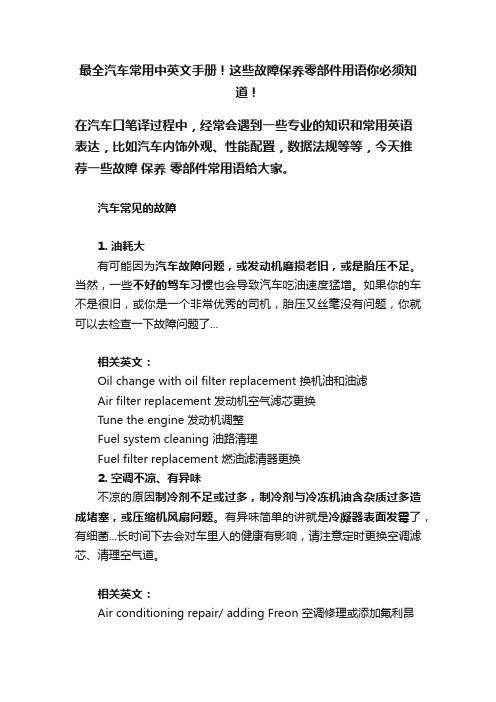
最全汽车常用中英文手册!这些故障保养零部件用语你必须知道!在汽车口笔译过程中,经常会遇到一些专业的知识和常用英语表达,比如汽车内饰外观、性能配置,数据法规等等,今天推荐一些故障保养零部件常用语给大家。
汽车常见的故障1. 油耗大有可能因为汽车故障问题,或发动机磨损老旧,或是胎压不足。
当然,一些不好的驾车习惯也会导致汽车吃油速度猛增。
如果你的车不是很旧,或你是一个非常优秀的司机,胎压又丝毫没有问题,你就可以去检查一下故障问题了...相关英文:Oil change with oil filter replacement 换机油和油滤Air filter replacement 发动机空气滤芯更换Tune the engine 发动机调整Fuel system cleaning 油路清理Fuel filter replacement 燃油滤清器更换2. 空调不凉、有异味不凉的原因制冷剂不足或过多,制冷剂与冷冻机油含杂质过多造成堵塞,或压缩机风扇问题。
有异味简单的讲就是冷凝器表面发霉了,有细菌...长时间下去会对车里人的健康有影响,请注意定时更换空调滤芯、清理空气道。
相关英文:Air conditioning repair/ adding Freon 空调修理或添加氟利昂Cabin filter replacement 换空调滤芯3. 行车过程中发动机温度超过正常标准原因:也许是冷却系统有严重的漏水情况,或是风扇传送带松脱,也可能是水泵轴与叶轮松脱,总之...送修吧...相关英文:Radiator repair 散热器修理Anti-freeze change 防冻液更换4. 刹车问题有时候刹车片薄了需要换,有时候刹车有尖锐的声音,等等刹车问题都需要认真对待哟。
相关英文:Break pads replacement 换刹车片Break fluid change 换刹车油Brake rotor resurfacing 刹车盘翻新Brake calipers adjustment 刹车卡钳调整Check level and refill brake fluid 检查添加刹车油5. 车打不着火如果你上车之后发现车子打不着火,那么很大的可能是你的电瓶坏掉了或是没电了...相关英文:Battery replacement 电瓶更换Alternator repair 交流发电机修理6. 轮胎异常磨损轮胎异常磨损虽然轮胎磨损是我们一定会面对的问题,但是不正常的轮胎磨损可能预示着你的爱车生病了。
维修手册英文版
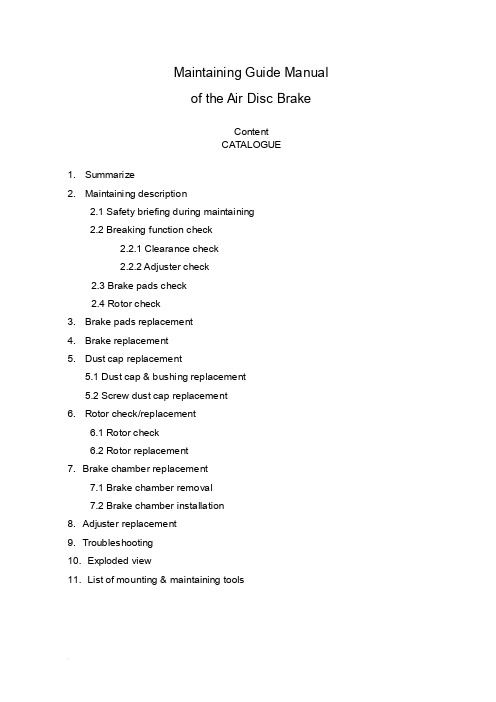
Maintaining Guide Manualof the Air Disc BrakeContentCATALOGUE1. Summarize2. Maintaining description2.1 Safety briefing during maintaining2.2 Breaking function check2.2.1 Clearance check2.2.2 Adjuster check2.3 Brake pads check2.4 Rotor check3. Brake pads replacement4. Brake replacement5. Dust cap replacement5.1 Dust cap & bushing replacement5.2 Screw dust cap replacement6. Rotor check/replacement6.1 Rotor check6.2 Rotor replacement7. Brake chamber replacement7.1 Brake chamber removal7.2 Brake chamber installation8. Adjuster replacement9. Troubleshooting10. Exploded view11. List of mounting & maintaining toolsBrief introduction of YOUFINYOUFIN was established on May 20th, 1998. It is a Sino-Foreign joint-venture enterprise registered in Wuhan Economic and T echnological Development Zone with multi-investors among which private investors dominate. It is a professional company engaged in manufacturing disc brakes and serving the principal automobile manufacturers by providing modularized supply. The main prod ucts cover hydraulic disc brakes and air disk brakes in close to thirty sizes.YOUFIN developed the air disc brake autonomously and patented the product. So far we are the only manufacturer in China that can mass produce air discs to be used in long distance coaches and inner city buses. It is evaluated that the quality of our products is close to the advanced international level in field use. The product development is part of the National T orch Plan and is also sponsored by the Small and Medium-sized Enterprise T echnical Innovation Foundation of Chinese Ministry of S&T.Our Air Disc Brake products are on an absolute leading position in China and the same international level as far as the key technology is concerned.1. SummarizeYOUFIN Air Disc Brake has four sizes (16’’, 17.5’’19.5’’, 22.5’’). It can satisfy different vehicles. The brakes have compact structure; automatically wear compensation and can easily changing the brake pad.2. Maintaining descriptionSafety briefing during maintainingIt’s most important to ensure safety driving and breaking by goodcharacteristics of the brake.Observe brake pad and rotor wear limits. When they warned already to assigned smallest thickness, it need replace immediately, otherwise, it may cause the accident. The pads scorches, grinds or greases must replace immediately.Every pad on each bridge must replace at the same time.When services the brake, the vehicle must park in smooth gound and the wheel withstand with the block/ stone prevent rolls.Note:●Must guarantee it does not occur with careless brake. When replace brakepad don’t make the brake, otherwise, it will hurts the body!●Do not use the compressed air or other cleaning up equipment clean thebrake, in order to avoid injures the body.●Be sure your hands and fingers place outside the caliper, in order to avoidinjures the body.●When moves and installs the brake should have some assistance, avoids ittoo heavy to hurts the body.●When take off the brake to make maintenance, it must fix on the clamp withhigh strength bolt, in order to avoid hurts the body.●Only allowed genuine YOUFIN kits and pads permitted by YOUFIN. Duringthe first 50 miles driving after new pad replacement, should avoid promptlybrake and brake at a long distance, Prevent overhigh temperature.●Allowed genuine YOUFIN kits and brake pads permitted by YOUFIN.●Only can use the recommendation kits in service. Screws the bolt/nutaccording to the request moment of force.Brake Function checkClearance checkProcess:●T ake off the hexagon bolt (39), loosen the pad retainer (38).●Remove pad retainer (38) from caliper.●Remove 3pcs of pad clip (37).●Move the cable (40) to the side.●Push the caliper towards the wheel and check the clearance with tune-upgauge.0.5mm ≤ clearance ≤ 1.2mmNote: Insert tune-up gauge between the caliper (1) and the brake pad (35). Should check the adjuster while the clearance is out of standard.Adjuster checkProcess:●Remove the rubber cap (12).●Turn hexagon head (22) clockwise by wrench to ensure clearance larger than3mm. (Or remove the brake pad and the push board)Note:a. Need enough room (3mm<clearance) for turn adjuster preventing un-fit.b. Never force to adjust the hexagon head (22) and/or the adjuster!Push the pressure arm 5 times in small increments and observe the hexagon head (22). While the adjuster is in good condition, hexagon head (22) must rotate clockwise.c. As the regulated quantity increase, rotation angle decreases.If the adjuster hexagon head (22):a) Not running at allb) Only running at first pushc) Running, but stopped in the middleWhile considers adjuster failed. Y ou should replace the brake on the basis of section 4 or change the adjuster in accordance with section 8.●Keep the clearances at 1mm (section 3) after adjuster check is finished.●Reinstall the rubber cap (12).Brake pads wearing check●Scorches, grinds and greased brake pad must replaces immediately.●Brake pads at the same bridge must replace at the same time.●Brake pad and pad clip must replace at the same time.Rotor checkProcess:●Remove the brake pad according to section 3.●T est thickness of the rotor.Note: Observe the brake pads and the rotor attrition situation. Excessive attrition of the rotor and the brake pads will reduce their potency and causes the brake fail!CAUTION: Rotors on the same bridge must replace at the same time. Single side rotor replacement is unacceptable. Recommend installs new brake pads whilereplace the new rotors.Rotor Dimension limitsRotor jumpiness (↗) check:2.4.1 Process:●Installs division indicator on the bracket (dial guage).●Measure jumpiness (↗) through turns the wheel. Jumpiness (↗) should lessthan 0.15.●Replaces the rotor to satisfy the request of section 6.●Modified brake pad should fulfil the specific requirements in section 3.2.4.2 Rotor test:At each change of Pads check the Rotor for grooves and cracks.The diagram at the right shows possible conditions of the surface.A = Small cracks spread over the surface are allowedB = Cracks less than 0.02in. (0.5mm) wide, running in a Radial direction, are allowedC = Grooves (circumferential) less than 0.06in. (1.5mm) wide are allowedD = Cracks in the vanes are not allowed and the Rotor MUST BE REPLACED.a = Pad contact area3. Brake Pad replacementNote: Do not use the pipe spanner/ board die! Keep your hands and fingers outside the caliper avoid the hurts of body!Brake Pad dismantle process:●T ake off hexagon bolt (39) from the Pad Retainer with spanner.●Remove the pad retainer from caliper (1).●T ake off the pad clip (37), which is above the pads (35,36) and push board (19).●Remove the sensor on brake pad.●T ake off the push board (19) & the brake pads (35,36).●Adjust hexagon head to make tappet back to the initial position.●Clean the pad groove & push board and anchor surface with brush.Note: Don’t hurt the dust cap (5 & 10). Be sure of no grease on installation surface!●Check the adjuster on the basis of section 2.2.2.Note: Fix the key while checking & turning the adjuster cap to avoid screw rotate.●Check the rotor according to section 2.4.3.2 Brake pad installing process:●Need enough room between the caliper & the rotor to insert brake pad.●Insert push board (19) at the place the caliper combine with the adjust screw.Note: Push board must on the bracket supporting surface. Adjust screw pin must in groove. Otherwise it will do harm to Adjuster mechanism. Ensure the dust cap untwisted by rotate the adjust screw.●Insert the cable sensor to pad groove. Fix cable on bearing (40).Note: The sensor contactor must face the brake disc and installs at the correctposition. Attention the wire trend to prevents the friction.●Insert new pad (36) at side of the push board.●Push caliper toward the wheel until the pad touch the rotor.Insert the brake padat wheel side.Note: Don’t adjust hexagon head violently.Note: Turn the adjuster counter-clockwise to decrease the clearance between pads.Don’t install the retainer before adjustment.Note: Check the rubber cap (12), be sure it is correctly seated.4. Brake replacementNote: Don’t use pipe wrench. Ensure your hands and fingers outside the caliperavoid hurt your body!Note: The Brake will supplies in assembly.CAUTION: The left brake and the right brake cannot exchange. Arrow direction on the brake is same as the forward direction of the wheel.4.1 Brake removal process:●Remove brake pad (see Section 3).●Release nut on the caliper, take of brake chamber.●Remove brake assessment from the bridge.●Check brake pad on the basis of section 2.3.●Check rotor on the basis of section 2.4.4.2 Brake installing process:●Install the new brake over rotor on the bridge. Screwed bolt with the spanner.Note: The right install order of the bolt is screwed both side symmetry.●T ake down the flange protection cap on the brake chamber.Note:Air chamber installment position. Open the scupper faces the ground, and stops other mouths.●Install brake pad and push board on the basis of section 3.●Install the air chamber and tighten with spanner.●Adjust the clearance.5. Guide Pin dust cap replacementNote: Do not use the pipe spanner/ board die! Keep your hand & finger outside the caliper, in order to avoid injuries.Note: When replaces all dust cap of guide bushing, section 5.1 & 5.2 should unify to avoids repetitive work. Single bushing replacement according to 5.1 and 5.2 corresponding work orders.5.1. Dust cap & bushing replacement●T ake off the brake pad according to section 3.●Loosen the chamber bolt and remove the brake chamber from caliper.●Remove the caliper assessment from bridge.●T ake off the steel cap (11) from guide bushing (8 & 9) by suitable tools.Dismantle caliper (1) from the bracket (2).Note: Don’t hurt the hole, the lid while open the steel cap with tools.●Loosen the bolt (6 & 7); separate the caliper (1) from the bracket (2).Note: When caliper moves, it may hurt body.●Cleaning up the bracket bonding plane●Take off the guide pin (8&9) on caliper (1). Then remove the dust cap (5).●Presses out bushing 4 with mandril from caliper1.●Cleans up the guide pin hole of caliper.Installing process:●Long guide pin hole must press in two new bushings. Short guide pin holepress in one.●Guarantee the size in drawing.●Greases between them and the bushing●Install new dust cap in the guide pin hole.Note: Cleans up the guide pin hole and grease the edge of dust cap before install for easy installation. Ensure the dust cap installs steadily, without crease and inside the ring groove of the caliper.●Install long/short guide pin to each hole and dust cap upside set in guide pinring groove.●Put the caliper (1) on the bracket (2) and plug guide pin (8&9) in guide hole.●Plug new bolt (6&7) (long one for pin 8, short one for pin 9) and screwed onbracket (2) with spanner.Note: Assembly must be careful, don’t damage the dust cap (5). First, screws bolt on long pin (8), and then screws bolt on short pin (9).When service maintenance, remove the guide pin (8&9) and replace by new bolt (6&7)!●Move the caliper on guide pin (8,9) forward and backward to check whether thecaliper can move freely.●Put on new copper cap on caliper (1) hole and push it in with correct kits. Note: Avoids the hurts of surface.●Raising the guide pin dust cap (5) carefully for cancel the air pressure.●Install brake across the rotor on bridge. Screwed bolt with the spanner.Note: Correct install process of the hexagon bolt.●Install brake pads and adjust clearance. Implemented section 3, notice theexplanation.●Cleaning the install flange on caliper and grease inside the pressure arm ballsocket before reinstall the brake chamber.●Install the brake chamber and screwed with spanner.Note: After the installation of brake chamber, the lowest chamber hole face theground must open, other mouths stop up.5.2. Screw dust cap replacementNote: If only replace the screw dust cap, does not need to remove the caliper andthe air chamber.Process:●Remove brake pad and push board according to section 3.●Push the caliper towards to brake chamber.●T ake off screw dust cap (10) from the ring groove on adjust screw (21).●T ake down from dust cap base with screwdriver.●Check screw thread.●Turning the adjust bolt for 30mm clockwise with the spanner.●Inspection thread corrosion and whether is damaged.●Turning it clockwise, feeling its lubrication and check the adjust screw thread.●Clean the base of caliper dust cap (10). (Arrow pointed)●Push new dust cap (10) on adjust screw. Install it on the base with kits. Observes itinstalls whether arrived.●Grease on the edge of dust cap (10) and install it on the base of adjust screw (21).Note: Guarantees the dust cap steadily in place and does not have the corrugation in the adjust screw ring groove.Installation process:●Install the brake pad and adjust the clearance (see Section 3).6. Rotor check/replacement6.1 Rotor check Check the rotor (Section 2.4) If the rotor reached the minimumthickness, it must be replaced.6.2 Rotor replacementNote: Generally recommend use new brake pad while install new/machined rotor.6.2.1 Uninstall the rotor:●R emove the brake pad. (see section 3)●T ake off the brake chamber. (see section 7)●T ake down brake from bridge. (see section 4)●T ake off the wheel and the rotor.(Refer to V ehicle Manufacture’srecommendations)6.2.2 Rotor installation:●I nstall the wheel and rotor. (refer to V ehicle Manufacture’s recommendations)●D egrease the rotor.●T urn the wheel and check the installed rotor (Section 2.4).●A djust ABS sensor refer to V ehicle Manufacture’s recommendations.●I nstall the brake (see Section 4).●I nsert pad (see Section 3).●I nstall brake chamber (see Section 7).7. Brake chamber replacementNote: Don’t use pipe wrench! Ensure your hands and fingers outside the caliperavoid hurts body!Note: Can only use the chamber assigned by the Vehicle Manufacture.7.1. Brake chamber removal:●Bleeds off the compressed air.●Remove the upper air pipe of brake chamber.●Remove the chamber from caliper.7.2. Brake chamber installation:Note: According to the brake installment position, only can open the scupperunderneath.●Cleans the sealing plane of the pressure are ball socket (arrow) and caliper beforethe brake chamber installation.●Screwed the chamber mounting nut alternately with spanner in torque ratingrequired by the air chamber supplier.●Connection the air pipe.Note: Never twist the braking line, place it originally avoid fiction with other sets.While exist air leak, finds the leakage and check the connection.●Function and performance examination.8. A djuster replacement8.1 A djuster removal●Remove brake pad (see Section 3).●Remove brake chamber (see Section 7).●T ake off brake (see Section 4).●T ake off upper bolt by hexagon wrench.●Remove adjuster and other parts in the caliper.Note: Don’t hurt the screw dust cap.8.2 A djuster installation●Grease inside the caliper.●Put the return spring (18) at each side.●Install the needle assembly and the adjuster.●Puts the washer and top head, screwed the bolt with spanner according to theopposite angle principle.Note: Guarantee the bolt tighted the moment of force.9. Troubleshooting11. List of mounting & maintaining toolsYOUFIN is in the process of logo replacement, new logo will put into practice gradually. It with the original logo is still the YOUFIN’s product. Final interpret right for the logo belongs to YOUFIN.。
Let’s Fly Outdoor 助行器的维修手册说明书

SERVICE MANUAL Let’s Fly Outdoor rollatorfrom TrustcareTABLE OF CONTENTSExchange of fender Page 3Exchange of rear wheel Page 4Exchange of rear wheel mounting plate Page 5Exchange of brake yoke Page 7Exchange of rubber springs Page 8Exchange of front wheel Page 9Exchange of brake housing and brake leverPage 10 Exchange of front fork and bearings Page 12Exchange of seatPage 13Exchange of brake wire Page 14Exchange of handle and handle tube Page 16Exchange of linkage arm Page 18Exchange of wire guide Page 19Exchange of height adjustmentPage 20Exchange of middle joint folding cross Page 21Page 22Art. No. 0468N Art. No. 0473NArt. No. 0474, 0475Art. No. 0476Art. No. 0480Art. No. LF304Art. No. LF306Art. No. LF318Art. No. LF301, LF302, LF324Art. No. LF305Art. No. LF307, LF308Art. No. LF312, LF321Art. No. LF313Art. No. LF320Art. No. LF326Art. No. LF311Exchange of unfold hook Adjustment of unfold hookAdjustment of brake/parking brake Art. No. LF311Art. No. LF306Page 23Page 23Let’s Fly Spare part. Art. No. 0468N.Let’s Fly Service Manual. Revision version No: 2 – Aug 2017 Exchange of fender Let’s Fly.1. Unscrew the double screw A and the two screws B holding the fender.2. Pull out the rear wheel mounting plate just enough to free the fender.3. Unscrew the wheel cap and remove the damagedfender.4. Screw the new fender and the wheel cap in place.5. Turn the fender into correct position and tighten the wheel cap screw..6. Push the assembly into the rear leg and screw back the screws A and B.5. The wheel can be taken off and replaced with a new one.4. To replace the rear wheel, open the retaining ring (snap-ring) with a pliers.6. Use the pliers to lock the new snap-ring firmly into the groove on the axle.Let’s Fly Spare part. Art. No. 0473N.Let’s Fly Service Manual. Revision version No: 2 – Aug 2017Exchange of rear wheel Let’s Fly.1. Unscrew the double screw A and the two screws B holding the fender.2. Pull out the rear wheel mounting plate just enough to free the fender.3. Unscrew the wheel cap and remove the fender.7. Screw the fender and the wheel cap back in place.8. Turn the fender in correct position and tighten the wheel cap screw.9. Screw back the screws A and B.9. Use the pliers to lock the snap-ringfirmly into the groove on the axle.1. Unscrew the double screw B and the two screws C holding the fender.4. Remove the yoke from the wire and the mounting plate.2. Put the handle in lowest position.3. Pull out the brake, sleeve, fender, and the wire guide from the rear leg.7. Remove the wheel from the old mounting plate 8. Put the wheel on the new mounting plate.5. Unscrew the wheel cap and remove the fender.6. To remove the wheel, remove the retaining ring (snap-ring) with a pliers.12. Check brake function when the wire has a loop, see picture.13. Attach the wire guide to the top of the sleeve.14. Make a loop on the wire.16. Mount the brake yoke and wire onto the wheel plate.15. Push the sleeve and wire guide into the rear leg.18. Push the whole assembly into rear leg and screw back the screws.17. Put the fender in place.10. Put back the fender and wheelcap.11. Mount the wire and the spring on the yoke.Let’s Fly Spare part. Art. No. 0476.Let’s Fly Service Manual. Revision version No: 2 – Aug 20171. Push the handle down to lowest position.2. Unscrew the double screw A and the two screws B holding the fender.3. Pull out the mounting plate with the brake yoke from the rear leg.6. push the whole assembly into the rear leg including the fender.7. Screw the double screw A and the two screws B back in place.Exchange of brake yoke.4. Remove the damaged brake yoke and put in the new one.wheel mounting plate.Let’s Fly Spare part. Art. No. 0480.Let’s Fly Service Manual. Revision version No: 2 – Aug 2017Exchange of rubber springs on rear wheel.1. Unscrew the double screw B and the two screws C holding the fender.2. Pull out the brake just enough so you can take away the rubber springs.5. Put fender in place and push the whole brake assembly into the rear leg including the fender.6. Screw the double screw B and the two screws C back in place.4. Don’t forget to put the distance sleeve into the yoke.3. Remove the damaged rubber springs and put in the new ones.Let’s Fly Spare part. Art. No. LF 304.Exchange of front wheel Let’s Fly.1. Unscrew screw B and remove the C-clip at C.2. Remove the old wheel from the front fork. Let’s Fly Service Manual. Revision version No: 2 – Aug 20173. Put the new wheel onto the axle including the two ball bearings.4. Lock the wheel with the C-clip and screw the hub cap in place over the hub with screw B.Let’s Fly Spare part. Art. No. LF306.Exchange of brake housing, brake lever. Page 11. Unscrew the double screw B and the two screws Cholding the fender.2. To make is simple to remove the brake components you can use a hook tool like the one in the picture.Let’s Fly Service Manual. Revision version No: 3 – Okt 20193. Pull out the brake fender.4. Use the hook tool to pull out the sleeve and wire guide separately.6. Unscrew the screw on the handle and pull out the brake housing and brake lever .5. Unmount the brake from the wire.7. Dont remove the brake wire from the old brake handle.Exchange of brake housing, brake lever. Page 29. Attach the wire to the adjustment screw and screw the brake mechanism into the handle.Let’s Fly Spare part. Art. No. LF306.Let’s Fly Service Manual. Revision version No: 2 – Aug 201711. Make a wire loop on the wire guide. Put the wire on the yoke.12. Push the sleeve and wire guide into the rear leg.14. Push the whole assembly into the rear leg and screw back the screws B and C.13. Mount the yoke on the wheel mounting plate and turn the fender into correct angle.10. Screw the height adjustment mechanism back in place.8. Now the new lever and housing can be mounted.Let’s Fly Spare part. Art. No. LF 318 LF322.Exchange of front fork and bearings Let’s Fly.1. Remove the plastic top cap.2. Unscrew the nut A and take out the front fork and bearings.Let’s Fly Service Manual. Revision version No: 2 – Aug 20173. Unscrew screw B, remove the C-clip and remove the wheel from the fork.4. Mount the wheel on the new fork with clip C and screw B including the two ball bearings.6. Put back the plastic top cap.5. Mount the new bearing into the front leg of the rollator and tighten nut A.5. Put the new seat into the tubes and put in the two metal rods. Make sure that the direction of the seat is correct. If necessary exchange the rods and dome nuts.6. Screw the dome nuts in place.7. Put the fabric band into the slot in the unfold hook.Adjust the length of the band so that the hook locks the rollator in open position and releases when you lift the seat in the middle opening.Let’s Fly Spare part. Art. No. LF301, LF302. Art. No. LF324.Let’s Fly Service Manual. Revision version No: 2 – Aug 2017Exchange of seat and seat mounting set.1. Partly fold the rollator so that the seat is loose and not stretched.2. Screw off the dome nuts in one end, both sides of seat. Use allenkeys if necessary. Pull out the rods.3. Remove the fabric band from theunfold hook.4. If the seat is to be exchanged, pull out the seat fromthe metal tubes.Snap1. Unscrew the double screw B and the two screws C holding the fender.2. Unscrew screw A and remove the height adjustment.3. Pull out the brake, sleeve, fender, and the wire guide from the rear leg.6. Unscrew the screw on the handle and pull out the brake mechanism.4. Disconnect the wire and pull out the handle tube from the frame.5. Remove the bottom plug from the handle tube and take out the wire. 8. Remove the old brake wire entirely from the frame and the handle.7. Unscrew the wire adjustment screw and take out the brake wire.9. Insert the new wire in the handle tube from bottom and up.AHandle tube12. Put the brake wire and handle tube into frame.11. Put the wire into the bottom plug and push the bottom plug in place.10. Attach the wire to the adjustment screw and screw in the mechanism.14. Make a wire loop on the wire guide. Attach the wire to the yoke.16. Mount the brake yoke and wire onto the wheel plate.15. Push the sleeve and wire guide into the rear leg.18. Push the whole assembly into rear leg and screw back the screws.17. Turn the fender in place.13. Screw the height adjustment mechanism back in place.SnapLet’s Fly Spare part. Art. No. LF307 LF308.1. Unscrew the double screw B and the two screws C holding the fender.2. Unscrew screw A and remove the height adjustment.Let’s Fly Service Manual. Revision version No: 2 – Aug 20173. Pull out the brake, sleeve, fender, and the wire guide from the rear leg.6. Unscrew the screw on the handle and pull out the brake mechanism.4. Disconnect the wire and pull out the handle tube from the frame.5. Remove the bottom plug from the handle tube and take out the wire. 8. Remove the wire from the old handle tube.7. Unscrew the wire adjustment screw and take out the brake wire.9. Move the plastic bushing from the old handle tube to the new one.A12. Put the brake wire and handle tube into frame.11. Attach the wire to the adjustment screw and screw in the mechanism.10. Put the wire into the new handle tube all the way up to the handle.Let’s Fly Spare part. Art. No. LF307.Let’s Fly Service Manual. Revision version No: 2 – Aug 201716. Mount the brake yoke and wire onto the wheel plate.14. Make a wire loop on the wire guide. Attach the wire to the yoke.15. Push the sleeve and wire guide into the rear leg.18. Push the whole assembly into rear leg and screw back the screws.17. Put the fender in place.13. Screw the height adjustment mechanism back in place.1. Drill out the rivets or unscrew the screws that hold the plastic linkage arm to the metal frame of the rollator.2. Remove the plastic part. Do not forget the metal reinforcement bar that is inside.Let’s Fly Spare part. Right Art. No. LF321. Left Art. No. LF312.Let’s Fly Service Manual.Revision version No: 2 – Aug 2017Mounting of linkage arm.4. Mount the parts using screws, washers, and nuts.3. Mount the new plastic arm with the reinforcement bar inside. On the left side the hook for folding and the spring should also be mounted.Let’s Fly Spare part. Art. No. LF313.Let’s Fly Service Manual. Revision version No: 2 – Aug 20171. Unscrew the double screw A and the two screws B holding the fender.2. Pull out the brake, sleeve, fender, and the wire guide from the rear leg.5. Push the sleeve and the wireguide into the rear leg.and springs to the mounting plate.7. Turn the fender into correct angleand tighten the wheelscap screw.8. push the whole assembly intothe rear leg including the fender.9. Screw the double screw A andthe two screws B back in place. Exchange of wire guide inside rear leg.3. Remove the damaged wireguide and put in the new one.4. Mount the new wire guide andmake a loop with the wire.Let’s Fly Spare part. Art. No. LF320.Exchange of height adjustment Let’s FlyLet’s Fly Service Manual. Revision version No: 2 – Aug 20171. Unscrew screw A and remove the damaged height adjustment.4. Put in the adjust mechanism and screw the screw A in place.2. The new height adjustment consists of three parts.3. Check that the holes in the plastic bushing, the frame and the handle tube correspond.AA1. These are the parts of the joint and how they should be mounted together.2. The tubes of the folding cross should be placed between the washers in this order according to this sketch.3. Tighten the dome nut securely. Fix the nut with a drop of Loctite so it will not fall off. The metal sleeve serves as a fixture peg for the hook when the rollator is folded.Dome nut Metal sleeve Screwplastic washers Metal washerMetal washer Front side of rollator Rear side of rollatorMetal sleeveLet’s Fly Spare part Art. No. LF326.Let’s Fly Service Manual. Revision version No: 2 – Aug 2017Mounting the middle joint of the folding cross.3. Unscrew the two screws that hold the hook in place and remove the hook.4. Mount the new screws, the new hook and the spring. The spring must be placed around the two screws and locked into the hole in the hook at A.5. Adjust the screws so that the hook can easily rotate and still fits smoothly into the slot in the plastic linkage arm.Let’s Fly Spare part. Art. No. LF311.1. Partly fold the rollator so that the seat is loose andnot stretched.6. Put the fabric band into the slot in the unfold hook.Adjust the length of the band so that the hook locks the rollator in open position and releases when you lift the seat in the middle opening.Let’s Fly Service Manual. Revision version No: 2 – Aug 2017Exchange of the unfold hook.2. Remove the fabric band from the unfold hook.Let’s Fly spare part. Art. No. LF311.1. If the hook doea not lock or doeas not fit in the slot it can be adjusted with screw A. For tightening turn clockwise according to picture.2. If the hook is too tight, loosen it by screwing counter clockwise according to picture.Let’s Fly Servicemanual. Revision version nr: 2 – Aug 2017Adjustment of unfold hook Let’s Fly.Let’s Fly spare part. Art. No. LF306.Adjustment of brake/parking brake Let’s Fly.1. If the brake is to loose the wire tension can be increased by turning the screw B counter clockwise.2. If the brake is too hard the tension can be loosened by turning the screw B clockwise.。
雨燕使用说明书
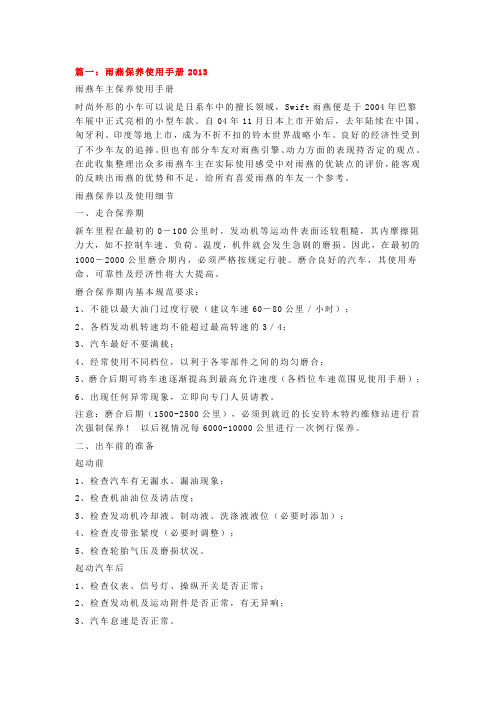
篇一:雨燕保养使用手册2013雨燕车主保养使用手册时尚外形的小车可以说是日系车中的擅长领域,Swift雨燕便是于2004年巴黎车展中正式亮相的小型车款。
自04年11月日本上市开始后,去年陆续在中国、匈牙利、印度等地上市,成为不折不扣的铃木世界战略小车。
良好的经济性受到了不少车友的追捧。
但也有部分车友对雨燕引擎、动力方面的表现持否定的观点。
在此收集整理出众多雨燕车主在实际使用感受中对雨燕的优缺点的评价,能客观的反映出雨燕的优势和不足,给所有喜爱雨燕的车友一个参考。
雨燕保养以及使用细节一、走合保养期新车里程在最初的0-100公里时,发动机等运动件表面还较粗糙,其内摩擦阻力大,如不控制车速、负荷、温度,机件就会发生急剧的磨损。
因此,在最初的1000-2000公里磨合期内,必须严格按规定行驶。
磨合良好的汽车,其使用寿命、可靠性及经济性将大大提高。
磨合保养期内基本规范要求:1、不能以最大油门过度行驶(建议车速60-80公里/小时);2、各档发动机转速均不能超过最高转速的3/4;3、汽车最好不要满载;4、经常使用不同档位,以利于各零部件之间的均匀磨合;5、磨合后期可将车速逐渐提高到最高允许速度(各档位车速范围见使用手册);6、出现任何异常现象,立即向专门人员请教。
注意:磨合后期(1500-2500公里),必须到就近的长安铃木特约维修站进行首次强制保养!以后视情况每6000-10000公里进行一次例行保养。
二、出车前的准备起动前1、检查汽车有无漏水、漏油现象;2、检查机油油位及清洁度;3、检查发动机冷却液、制动液、洗涤液液位(必要时添加);4、检查皮带张紧度(必要时调整);5、检查轮胎气压及磨损状况。
起动汽车后1、检查仪表、信号灯、操纵开关是否正常;2、检查发动机及运动附件是否正常,有无异响;3、汽车怠速是否正常。
注意:用户自己在保养车辆时请仔细阅读随车使用手册!三、行驶中注意事项1、冷机起动后,应让发动机预热3-5分钟,最初以中、低速行驶,发动机水温正常后才能高速行驶;2、从经济性及发动机寿命、环保等方面考虑要尽量使用高档行驶,因为此时在同样车速下,发动机的转速最低;3、当车下陡坡或长坡时,要挂上适当的低速档,用发动机辅助制动。
2018-2019-1.5雨燕说明书-推荐word版 (9页)
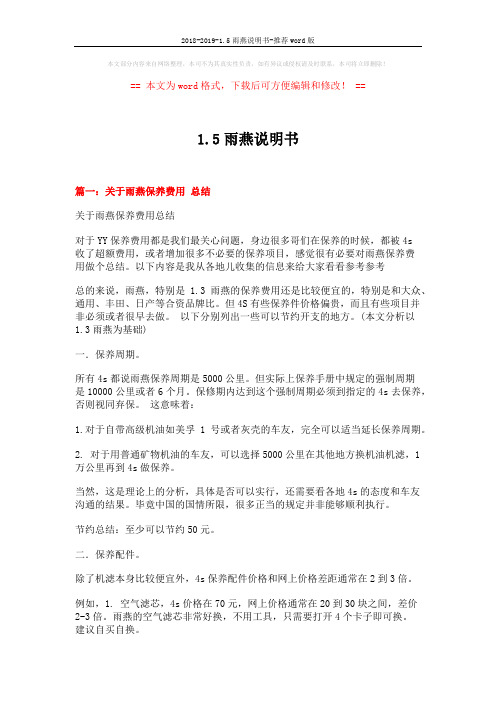
本文部分内容来自网络整理,本司不为其真实性负责,如有异议或侵权请及时联系,本司将立即删除!== 本文为word格式,下载后可方便编辑和修改! ==1.5雨燕说明书篇一:关于雨燕保养费用总结关于雨燕保养费用总结对于YY保养费用都是我们最关心问题,身边很多哥们在保养的时候,都被4s收了超额费用,或者增加很多不必要的保养项目,感觉很有必要对雨燕保养费用做个总结。
以下内容是我从各地儿收集的信息来给大家看看参考参考总的来说,雨燕,特别是 1.3雨燕的保养费用还是比较便宜的,特别是和大众、通用、丰田、日产等合资品牌比。
但4S有些保养件价格偏贵,而且有些项目并非必须或者很早去做。
以下分别列出一些可以节约开支的地方。
(本文分析以1.3雨燕为基础)一.保养周期。
所有4s都说雨燕保养周期是5000公里。
但实际上保养手册中规定的强制周期是10000公里或者6个月。
保修期内达到这个强制周期必须到指定的4s去保养,否则视同弃保。
这意味着:1.对于自带高级机油如美孚1号或者灰壳的车友,完全可以适当延长保养周期。
2. 对于用普通矿物机油的车友,可以选择5000公里在其他地方换机油机滤,1万公里再到4s做保养。
当然,这是理论上的分析,具体是否可以实行,还需要看各地4s的态度和车友沟通的结果。
毕竟中国的国情所限,很多正当的规定并非能够顺利执行。
节约总结:至少可以节约50元。
二.保养配件。
除了机滤本身比较便宜外,4s保养配件价格和网上价格差距通常在2到3倍。
例如,1. 空气滤芯,4s价格在70元,网上价格通常在20到30块之间,差价2-3倍。
雨燕的空气滤芯非常好换,不用工具,只需要打开4个卡子即可换。
建议自买自换。
1. 汽油滤芯,原厂为索菲玛品牌,此品牌淘宝价格通常在35元左右,4s价格在110元左右,差价在3倍多。
2. 机油滤芯,原厂15元左右,网上有10元左右的滤芯,差价不大,可以继续用原厂滤芯。
但对于延长换油周期的朋友,可以考虑用Denso等好品牌的滤芯。
【推荐】铃木雨燕,说明书,pdf-推荐word版 (7页)
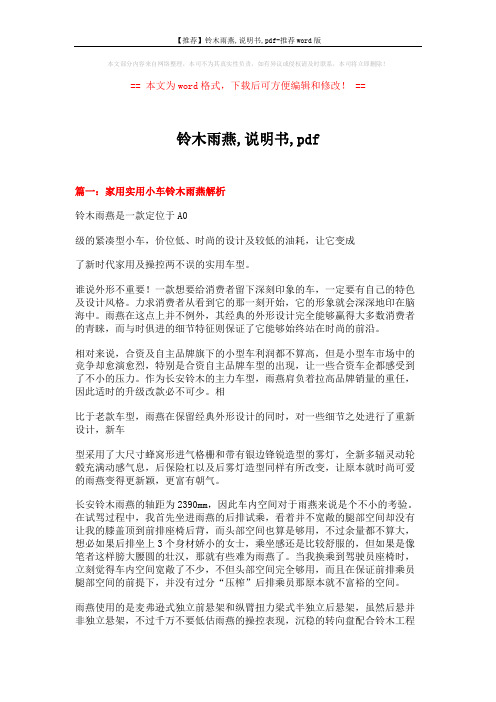
本文部分内容来自网络整理,本司不为其真实性负责,如有异议或侵权请及时联系,本司将立即删除!== 本文为word格式,下载后可方便编辑和修改! ==铃木雨燕,说明书,pdf篇一:家用实用小车铃木雨燕解析铃木雨燕是一款定位于A0级的紧凑型小车,价位低、时尚的设计及较低的油耗,让它变成了新时代家用及操控两不误的实用车型。
谁说外形不重要!一款想要给消费者留下深刻印象的车,一定要有自己的特色及设计风格。
力求消费者从看到它的那一刻开始,它的形象就会深深地印在脑海中。
雨燕在这点上并不例外,其经典的外形设计完全能够赢得大多数消费者的青睐,而与时俱进的细节特征则保证了它能够始终站在时尚的前沿。
相对来说,合资及自主品牌旗下的小型车利润都不算高,但是小型车市场中的竞争却愈演愈烈,特别是合资自主品牌车型的出现,让一些合资车企都感受到了不小的压力。
作为长安铃木的主力车型,雨燕肩负着拉高品牌销量的重任,因此适时的升级改款必不可少。
相比于老款车型,雨燕在保留经典外形设计的同时,对一些细节之处进行了重新设计,新车型采用了大尺寸蜂窝形进气格栅和带有银边锋锐造型的雾灯,全新多辐灵动轮毂充满动感气息,后保险杠以及后雾灯造型同样有所改变,让原本就时尚可爱的雨燕变得更新颖,更富有朝气。
长安铃木雨燕的轴距为2390mm,因此车内空间对于雨燕来说是个不小的考验。
在试驾过程中,我首先坐进雨燕的后排试乘,看着并不宽敞的腿部空间却没有让我的膝盖顶到前排座椅后背,而头部空间也算是够用,不过余量都不算大,想必如果后排坐上3个身材娇小的女士,乘坐感还是比较舒服的,但如果是像笔者这样膀大腰圆的壮汉,那就有些难为雨燕了。
当我换乘到驾驶员座椅时,立刻觉得车内空间宽敞了不少,不但头部空间完全够用,而且在保证前排乘员腿部空间的前提下,并没有过分“压榨”后排乘员那原本就不富裕的空间。
雨燕使用的是麦弗逊式独立前悬架和纵臂扭力梁式半独立后悬架,虽然后悬并非独立悬架,不过千万不要低估雨燕的操控表现,沉稳的转向盘配合铃木工程师精心调校的悬架,依然让驾驶者在高速过弯或者变线时镇定自若。
